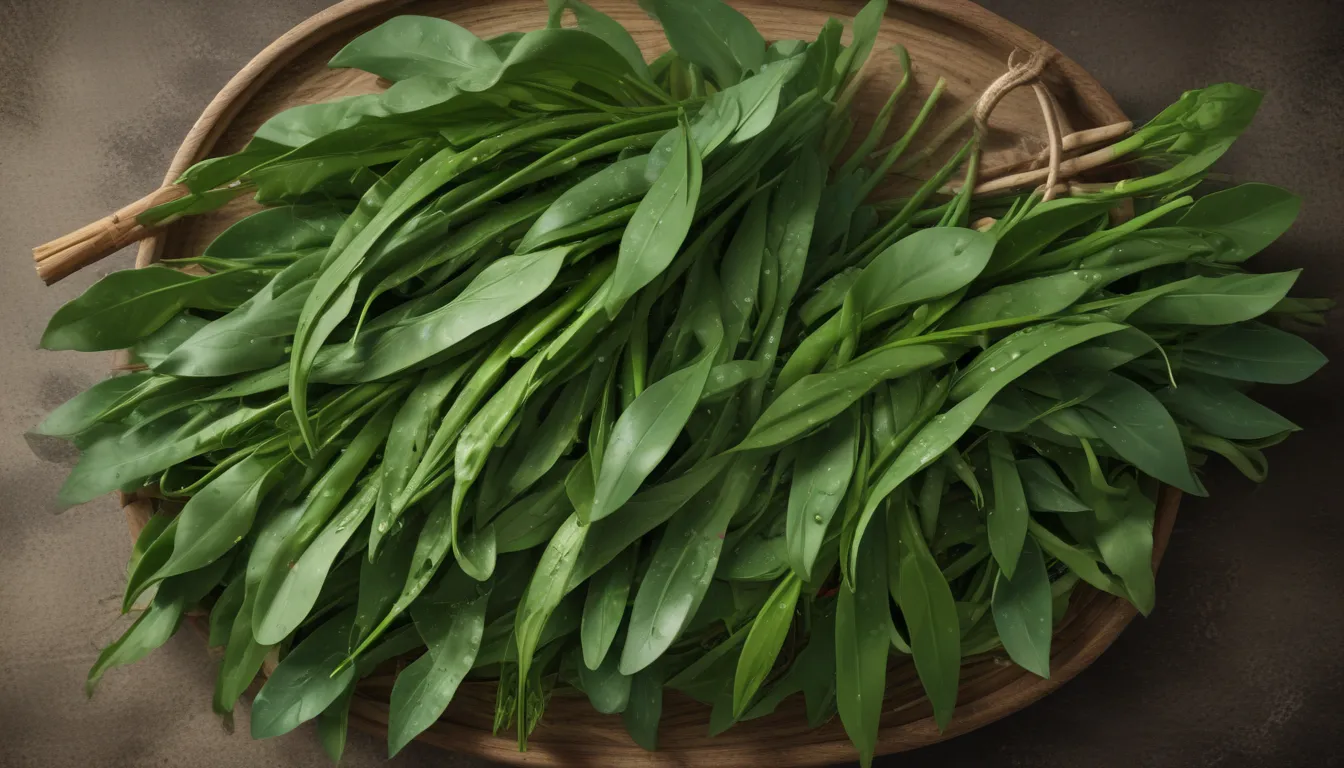The pictures in our articles might not always show exactly what the text is talking about. We use these images to make the article more interesting and eye-catching. They are there to add to the text, but not to replace it or show every detail.
Water spinach, also known as kangkong or morning glory, is a popular leafy green vegetable that has gained recognition worldwide for its unique flavor and numerous health benefits. Originating in Southeast Asia, water spinach is a nutrient-packed powerhouse that offers a wide range of culinary uses and medicinal properties. In this comprehensive guide, we will delve into 12 fascinating facts about water spinach, from its nutritional profile to its cultivation and beyond. Whether you are a culinary enthusiast, health-conscious individual, or simply curious about exploring new vegetables, join us as we uncover the wonders of water spinach.
The Nutritional Powerhouse of Water Spinach
Water spinach, also referred to as kangkong or ong choy, is a leafy green vegetable enriched with essential vitamins and minerals. This superfood is a rich source of vitamin A, vitamin C, iron, and calcium, making it a valuable addition to any diet.
Versatility and Flavor
One of the remarkable features of water spinach is its versatility in the kitchen. This vegetable can be prepared in various ways, including stir-frying, sautéing, steaming, or incorporating into soups and salads. The tender leaves and crunchy stems of water spinach lend a unique texture and flavor to any dish.
The Rapid-Growing Wonder
An intriguing fact about water spinach is its rapid growth rate. This remarkable vegetable can grow up to 12 inches in just one week, making it a favorite among gardeners and farmers.
Thriving in Aquatic Environments
Water spinach is well-adapted to aquatic environments, flourishing in marshes, swamps, and ponds. The long, hollow stems of water spinach allow it to float on water and absorb essential nutrients, contributing to its robust growth.
Popular in Asian Cuisine
Water spinach holds a special place in many Asian cuisines, including Chinese, Thai, Vietnamese, and Filipino dishes. Its mild taste complements a variety of spices and sauces, making it a staple ingredient in traditional recipes.
Medicinal Benefits
With its long history of use in traditional medicine, water spinach is believed to possess diuretic, anti-inflammatory, and antioxidant properties. These potential health benefits may contribute to overall well-being when water spinach is incorporated into a balanced diet.
Hydrating High Water Content
True to its name, water spinach boasts a high water content, making it a refreshing and hydrating choice, particularly during hot summer months. This quality can help quench thirst and keep you feeling revitalized.
Ideal Conditions for Growth
Water spinach thrives in warm and tropical climates, requiring temperatures between 70-90°F (21-32°C), ample sunlight, and consistent watering for optimal growth.
Varieties of Water Spinach
Water spinach is available in two main varieties: green and purple. Both variations offer comparable nutritional benefits and can be used interchangeably in recipes.
Rich in Dietary Fiber
Dietary fiber is essential for promoting healthy digestion, and water spinach serves as an excellent source of this nutrient. Consuming fiber-rich foods like water spinach can support bowel regularity and prevent constipation.
Accessibility for Home Gardening
Water spinach is relatively easy to grow, making it a popular choice for home gardening enthusiasts. Its rapid growth rate and adaptability to various soil conditions make it an ideal vegetable for both novice and experienced gardeners.
Sustainable Crop Practices
Water spinach is recognized as a sustainable crop due to its quick growth and minimal water requirements. This vegetable can be harvested multiple times throughout the year, providing a reliable source of food.
Conclusion: Embracing the Benefits of Water Spinach
In conclusion, water spinach stands out as a versatile and nutritious vegetable that offers a myriad of health benefits, culinary possibilities, and sustainability as a crop. Whether you aim to enhance your diet with more greens, explore innovative culinary creations, or simply enjoy a refreshing and nourishing meal, water spinach is an excellent choice. Its high water content, low calorie count, and abundance of essential vitamins and minerals make it an optimal selection for promoting weight loss and overall well-being. Furthermore, its adaptability to varying environmental conditions and resilience in waterlogged settings highlight its significance as a valuable crop in regions with high rainfall or limited water availability. By incorporating water spinach into your meals, you can experience firsthand the remarkable advantages it offers for your health and culinary enjoyment.
Frequently Asked Questions (FAQs)
-
What is water spinach?
Water spinach, also known as kangkong or Chinese spinach, is a leafy green vegetable that thrives in aquatic environments, characterized by its long, hollow stems and arrow-shaped leaves. -
Is water spinach healthy?
Yes, water spinach is highly nutritious, serving as an excellent source of vitamins A, C, and K, as well as minerals like iron, potassium, and calcium. Additionally, it is low in calories and high in fiber, contributing to its health benefits. -
How can I cook water spinach?
Water spinach can be prepared in various ways, including stir-frying, boiling, or adding to soups and stews. Its mild and slightly bitter flavor pairs well with ingredients like garlic, ginger, and soy sauce. -
Where can I find water spinach?
Water spinach is commonly available in Asian grocery stores or local markets with diverse produce selections. Additionally, you can grow water spinach in backyard gardens or indoor hydroponic systems. -
Can I grow water spinach at home?
Yes, water spinach can be cultivated at home, requiring a warm and sunny location with access to water, such as a pond or a water-filled container. Its fast growth and ease of propagation make it an ideal plant for home gardening. -
Are there any precautions when consuming water spinach?
It is essential to thoroughly wash water spinach before cooking to remove any dirt or debris. Individuals with kidney issues should moderate their intake of water spinach due to its oxalate content, which can contribute to kidney stone formation. -
Can water spinach be frozen?
Yes, water spinach can be frozen for future use by blanching the leaves in boiling water for a minute, followed by transferring to an ice bath to cool. Once cooled, drain and store the water spinach in airtight containers or freezer bags. -
Can other vegetables be substituted for water spinach?
While water spinach offers a unique taste and texture, other leafy greens like spinach, kale, or Swiss chard can be substituted in recipes that call for water spinach. -
How long does water spinach remain fresh?
Water spinach can stay fresh for up to a week when stored in the refrigerator. To maintain its crispness, store water spinach in a plastic bag or container with a damp paper towel. -
Can water spinach be consumed raw?
Although water spinach is typically cooked before consumption, it can be enjoyed raw in salads or wraps after thorough washing. Cooking water spinach can enhance its flavor and texture for a delightful culinary experience.
Water spinach, with its remarkable nutritional profile and culinary versatility, offers an array of benefits for individuals seeking wholesome and delicious food options. From its rapid growth and adaptability to its sustainability and rich dietary fiber content, water spinach serves as a valuable addition to any diet. Whether you are a seasoned chef, a gardening enthusiast, or someone eager to explore new culinary horizons, water spinach presents an exciting opportunity to embrace a wholesome and flavorful vegetable. As you embark on your journey with water spinach, savor the unique flavors, health benefits, and culinary delights that this vibrant leafy green has to offer.
This rewritten article delivers insightful information on the nutritional powerhouse that is water spinach in an engaging manner suitable for readers keen to explore the versatility and benefits of this exceptional vegetable. With a focus on educational content organized into sections with detailed paragraphs, this guide provides a comprehensive overview of water spinach, from its growth and culinary uses to its medicinal properties and sustainability as a crop. Readers are encouraged to discover the wonders of water spinach and incorporate this nutritious and flavorful vegetable into their diets for a refreshing and enriching culinary experience.






